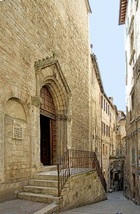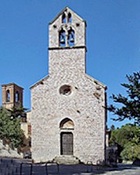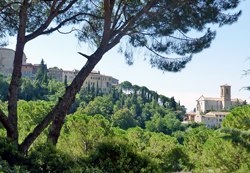
Rione di Porta Santa Susanna:
San Francesco (on the right)
was built outside the Etruscan walls,
on the site of the old church of Santa Susanna
Leave Piazza IV Novembre along Via Maestà delle Volte (part of Walk I) and turn immediately left along Via Ritorta (i.e. along the right side and then the back of Palazzo Vescovile). The walls of Via Ritorta are studded with the remains of the earlier public palaces that stood at the west end of Piazza IV Novembre:
-
✴There is an interesting tower house (13th century) at number 1 (on the right, at the corner with Via Antonio Fratti).
-
✴The road then turns right, and there is an empty niche in the wall ahead. This housed an image of the Madonna that was the subject of miracles in the frenetic year of 1796, after which it was moved to the Oratorio di Santa Cecilia (see below). A public toilet was later installed in the space below the niche.
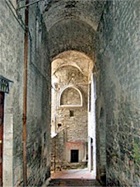



-
✴The tower house just beyond, at number 14 on the left incorporates what might have been part of Palazzo del Podestà (13th century), which stood on the site of the present Palazzo Vescovile until it burned down in 1329. The arch over the portal (13th 0r 14th century) has interesting reliefs of a horse (or more likely a donkey) on the left, a griffin on the right, and other animals above that are too damaged to identify.
-
✴The house of number 20 is a rare example of a surviving medieval “fondaco”, a house built over a shop or warehouse.
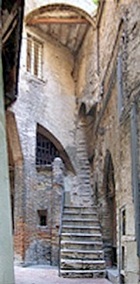
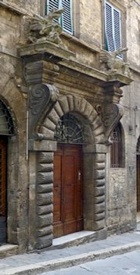
Turn left on leaving the church and continue along Via dei Priori. Take a short detour along Via Vermiglioli on the left to see Palazzo Vermiglioli, which is next to the Indian restaurant, at number 16 on the left.
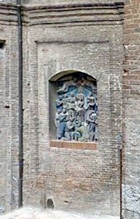

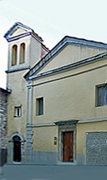
Sant’ Antonino Santa Croce
Before visiting San Filippo Neri, take a detour to see two small churches:
-
✴Turn left along Via della Cupa and then right into Via Deliziosa. An inscription on the house (15th century) at number 17 on the right, records that this was probably the site of the house and workshop of Perugino. The church of Sant’ Antonino is directly opposite it, at number 10.
-
✴Turn right at the end of the street and right again along Via Benincasa. The church of Santa Croce is on the left, set back from the road, with a small brick forecourt.
Turn right at the end along Via dei Priori and left into Piazza Ferri, which is named for the Perugian castrato Baldassarre Ferri (died 1680).
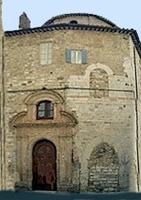
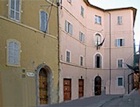
-
✴This square was originally named for the (now demolished) church of San Gregorio.
-
✴It also housed (at number 12-14) the Cistercian monastery of San Bernardo, which was re-dedicated as San Giovanni Battista in 1801.
-
✴The building beyond, at number 2 Via Vincioli, belonged to the Missionary Fathers of St Vincent de Paul from 1680. They were expelled during the period 1799-1815, and then again, this time definitively, in 1871.
-
✴The street and piazza assumed their present names in 1871, when the churches and monasteries here were converted for use as public offices.
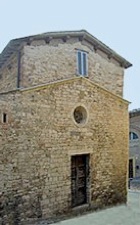
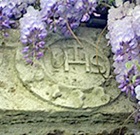

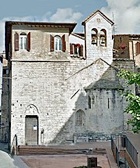
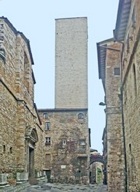
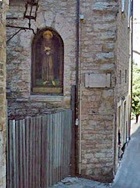
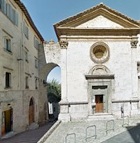
Walk through Porta Trasimena, and take a short detour down the steps and along Via Piscinello. According to tradition, a river of blood ran down this hill in 1482 from what is now Piazza IV Novembre after a ferocious battle between the Baglioni and the Oddi.
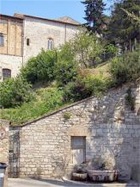
Retrace your steps the foot of the steps that lead to to Porta Trasimena.

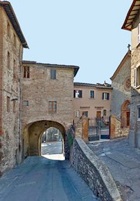
Walk through the gate and cross Viale Pompeo Pellini (avoiding the underpass, which is dark and dirty) and walk down the steps and along Piaggia Columbata, which follows the line of the ancient road from Perugia to Lake Trasimeno. The so-called Alfabetario di Perugia (late 6th century BC), which is a fragment from the rim of a vase that is inscribed with the Etruscan alphabet, was found here in 1970 during the construction of the sports stadium on your left. This is among a number of interesting objects that were found in the vicinity that are now in the Museo Archeologico.
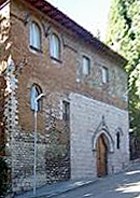
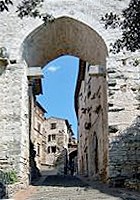

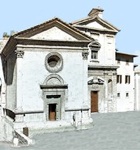
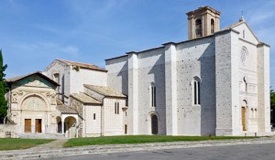
Continue into Piazza di San Francesco, which was the heart of the Franciscan community in Perugia. There are two important monuments on the left:
-
✴the Oratorio di San Bernardino, which incorporates the Oratorio dei SS Andrea e Bernardino; and
-
✴the remains of the church and convent of San Francesco al Prato, which now houses the Museo dell’ Accademia di Belle Arti. It was also the site of the Oratorio dei SS Girolamo, Francesco e Bernardino.
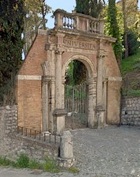
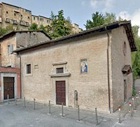
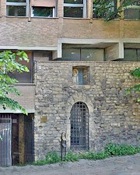
A Roman mosaic, which was discovered in 1875 in the orchard of Sant’ Elisabetta (and is described in the page on the church) can be visited via the door to the left of the church. This is now the Department of Chemistry of the University of Perugia, which was built in 1965 as part of the expansion of the University of Perugia in this area in the decades after 1950.
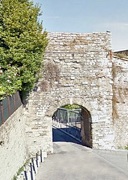
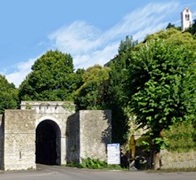
Porta Elce di Sopra Porta Elce di Sotto
The parish of Sant’ Elisabetta, which was the last new parish to be established in Perugia in the middle ages, was enclosed by a new stretch of walls that was built in 1327-42. Take short detour around the area to see two of the gates in this new section of the city wall:
-
✴Turn right on leaving the Department of Chemistry, right again along Via del Liceo and left at the end along Via Elce di Sotto. This takes you (somewhat confusingly) to Porta Elce di Sopra.
-
✴Walk though the gate and turn left along the stepped Via Adelmo Maribelli, which follows the walls to Porta Elce di Sotto (also called Porta Nuova della Conca). The campanile of San Matteo (visited earlier in the walk) is high up on the right.
-
✴Walk through this gate, along Via Alessandro Pascoli, which becomes Via Sant’ Elisabetta and takes you back to the Department of Chemistry.
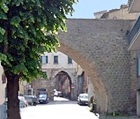
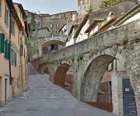
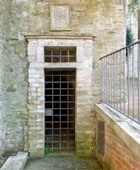
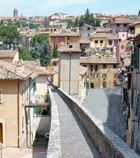

Turn right at the end into Via Baldeschi. Cross Piazza Cavallotti to Via Stella and turn immediately left into Via Maestà delle Volte (described in Walk I). This street leads back to Piazza IV Novembre, where the walk ends.




